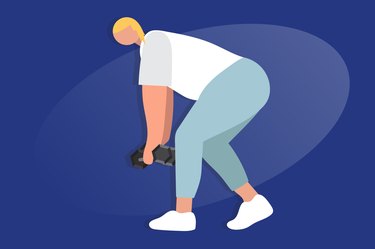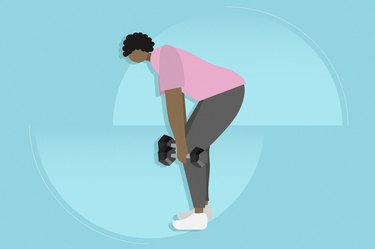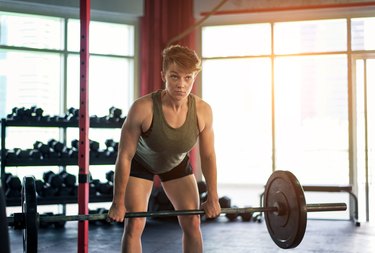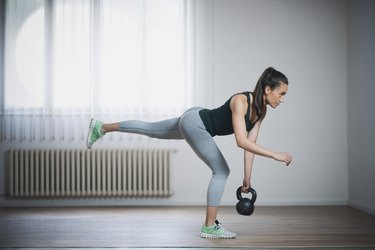

The deadlift is one of the best lower-body exercises out there — so it's no surprise it has its fair share of variations. The staggered-stance deadlift is one variation that's great for honing unilateral (one-sided) glute and hamstring strength, plus it works your core and balance.
- What is a staggered-stance deadlift? It's a unilateral variation of the Romanian deadlift (RDL), where you step one foot back behind your other so that you put the majority of your weight into the front leg.
- What does a staggered stance look like? To get into a staggered stance, start by standing with your feet together. Then, take a step back with one foot so that the back foot is a few inches behind the front heel and you're propped up on the toes of your back foot.
- What does a staggered stance do in a deadlift? The staggered stance allows you to isolate one leg at a time, which not only strengthens the muscles in each leg but also provides balance benefits, says Alexandra Orr, CPT, nutrition coach and host of health and fitness podcast Birdie and The Bees. "It also teaches you how to properly pick something up off the ground using the power of your legs while protecting your back."
- What muscles does the staggered stance deadlift work? Like the RDL, this deadlift variation works a ton of muscles, including your hamstrings, glutes, core, lats and forearms.
Video of the Day
What's the Difference Between a Staggered-Stance Deadlift and a B-Stance Deadlift?
The B-stance deadlift, aka kickstand deadlift, is very similar to the staggered-stance deadlift. The biggest difference is that instead of stepping your foot back behind the front foot, you also step it further out to the side so that your back toes are in line with your back heel but just a few inches to the right or left.
But the purpose is the same: The stepped-out foot acts as a support to help you keep your balance but isn't doing much (if any) of the heavy lifting.
How to Do a Staggered-Stance Deadlift With Proper Form
- Start with your feet together, holding a dumbbell in each hand in front of your thighs.
- Step your right foot about 6 to 12 inches back. Throughout the movement, you'll balance on the toes on your right foot.
- Keeping your left knee slightly bent, perform a deadlift by hinging forward at your hips. During this movement, make sure your hips remain squared forward.
- Continue lowering the dumbbells until your upper body is almost parallel to the floor if that's within your range of motion.
- Keeping your back flat, brace your core and push through your left foot to return to standing.
- Do all your reps on one leg, then repeat on the opposite side.
Watch the Full Tutorial
5 Staggered-Stance Deadlift Benefits
1. Builds Glute and Hamstring Strength
The main draw of any deadlift? It targets the entire back of the body — primarily the back of your legs (hamstrings) and your butt (glutes). The staggered stance makes it so that you do most of the work on one side, so you can really target those muscles.
It also allows you to go heavier. When you do a conventional deadlift, the weight you're holding in both hands is distributed across both legs. In a staggered-stance deadlift, you hold the same load, but one leg does most of the work.
Being able to isolate your glutes and hamstrings with targeted strength work makes this move great for hypertrophy, aka building muscle, Orr says.
2. Challenges Your Core
Like a conventional dumbbell deadlift, the staggered-stance deadlift requires your core to fire up, which also helps protect your lower back. However, it doesn't challenge stability and balance as much as a single-leg deadlift.
"It allows you to be more stable because both feet are still planted," Orr says. "Being more stable means you won't have to recruit those supporting muscles."
Ultimately, you won't be working your core and balance as much, which is part of why this deadlift variation is so good for focusing on maximizing strength gains in your glutes and hamstrings.
3. Preps You for a Single-Leg Deadlift
A single-leg deadlift requires you to lift the back foot completely off the floor, demanding more balance and coordination. The staggered-stance deadlift is a great transitional move that puts more emphasis on one leg and gets you ready to work up to a full single-leg deadlift.
4. Improves Muscle Imbalances
"If you have muscle imbalances where one side is stronger than the other, a movement like this is perfect for balancing that out by using a heavier weight or adding a couple of reps on the weaker side," Orr says.
Unilateral exercises can also help you learn about muscle imbalances you might not otherwise notice when you're doing the same lift with two legs and the stronger side can secretly take over.
5. Allows a Greater Range of Motion
"This staggered stance also allows for a greater range of motion when you're pushing your hips back," Orr says.
Moving through a larger range of motion when doing a lift increases the amount of time your muscles are under tension, leading to more strength gains. You also challenge a longer portion of the muscle. In this case, you get strong in different depths of a hinge — not just one.
The staggered-stance deadlift also gives you a nice stretch down the back of your body. On the flip side, if you have tight hamstrings, you won't be able to hinge forward enough so that your back is parallel with the floor. To help loosen them up, you can try doing these hamstring stretches as part of your warm-up routine.
4 Staggered-Stance Deadlift Form Tips
1. Master the Hip Hinge
The hip hinge is the basic movement that guides the deadlift. So start there to perfect the motion.
"When practicing the hinge, place your fingers on your hip bones," Orr says. "As you push your hips back into the hinge, your fingers should become sandwiched between your belly and thighs. This helps you understand what the hinge should feel like." (You can find a full video tutorial here.)
This will also help you move from your hips instead of your knees, which can put unnecessary force on the joint.
2. Keep Your Back Flat
Arching your lower back and hunching your upper back are two common deadlift mistakes. You want to keep your core engaged and your spine flat to avoid lifting from the wrong spots and hurting yourself.
"To correct arching of the [lower] back, squeeze your core and push your hips back behind you rather than bending down with your back," Orr says. To keep your upper back in check, set your shoulder blades back and down and think about keeping them engaged in this spot — don't let your shoulders come forward or your spine round.
Orr also suggests keeping your head slightly tucked and your gaze at the ground to avoid hunching or straining your neck.
3. Push Through Your Whole Front Foot
"To come up to standing, think about pushing that front foot away from the floor to use the power and strength of your leg to get yourself up," Orr says. You should balance on the toes of the back foot so that you can use it for support. But you shouldn't be pressing a ton of weight into this leg. Remember: The goal is to focus all of the work on your front leg.
4. Keep the Weights Close to Your Shins
Another common mistake is holding the weights too far from your body, Orr says.
"Instead of having your weights far away from your body, keep them as close to the shins as possible, almost to the point of touching," she says. Keeping the weights close to your center of gravity and the muscles that are working helps you better control them and avoid muscling them up with your arms or core.
3 Staggered-Stance Deadlift Variations
1. Staggered-Stance Deadlift With Resistance Band
- Start with your feet together and your left foot in the middle a long resistance band.
- Hold one end of the band in each hand and pull the band so there's no slack.
- Step your right foot about 6 to 12 inches back. Throughout the movement, you'll balance on your right toes.
- Keeping your left knee slightly bent, perform a deadlift by hinging forward at your hips, making sure your hips remain squared forward.
- Continue lowering until your upper body is almost parallel to the floor if that's within your range of motion.
- Keeping your back flat, engage your core and push through your left foot to return to standing.
- Do all your reps on one leg, then repeat on the opposite side.
2. Staggered-Stance Deadlift With Kettlebells
- Start with your feet together, holding kettlebells at your sides, palms facing in.
- Step your right foot about 6 to 12 inches back. Throughout the movement, you'll balance on your right toes.
- Keeping the left knee slightly bent, perform a deadlift by hinging forward at your hips, making sure your hips remain squared forward.
- Continue lowering the kettlebells until your upper body is almost parallel to the floor if that's within your range of motion.
- Keeping your back flat, engage your core and push through your left foot to return to standing.
- Do all your reps on one leg, then repeat on the opposite side.
3. Staggered-Stance Deadlift With Barbell
- Start with your feet together, holding a barbell with both hands in front of your thighs.
- Step your right foot about 6 to 12 inches back. Throughout the movement, you'll balance on your right toes.
- Keeping your left knee slightly bent, perform a deadlift by hinging forward at your hips, making sure your hips remain squared forward.
- Continue lowering the barbell until your upper body is almost parallel to the floor if that's within your range of motion.
- Keeping your back flat, brace your core and push through your left foot to return to standing.
- Do all your reps on one leg, then repeat on the opposite side.


